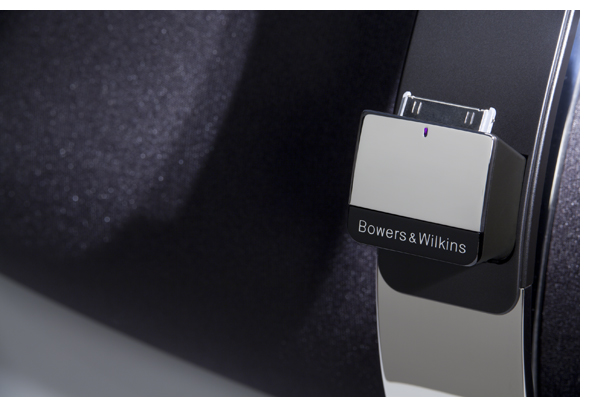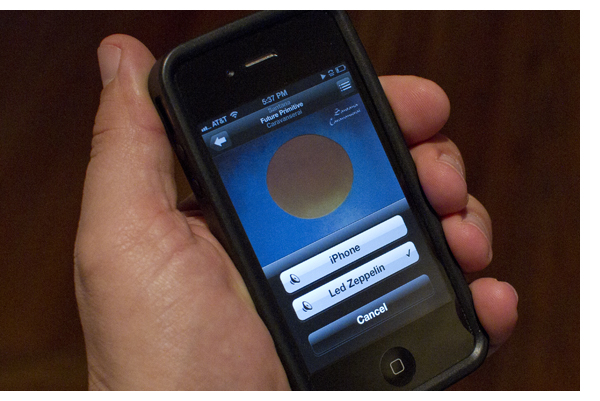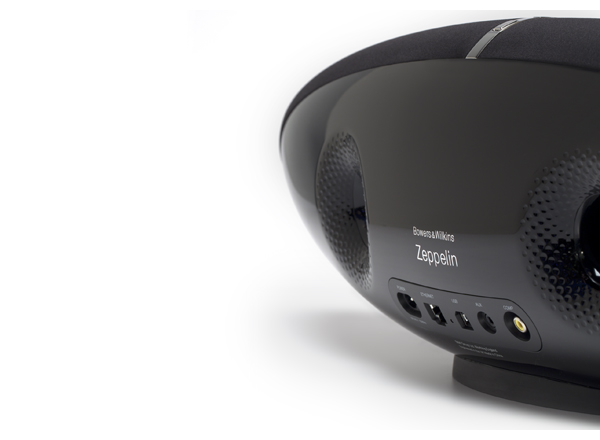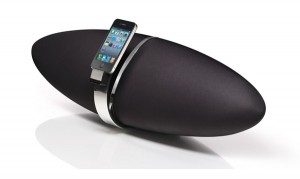 The quandary we’ve had was to put the Zeppelin in the iPod section of our website or review it as a regular hifi component. After spending quite a bit of time with it, we’ve all come away with the same conclusion: this is so much more than a fancy set of iPod speakers with a dock, it’s really a high performance portable audio system. You can add another digital component via the combined digital/optical input jack, just like the ones on an Apple Power Book. For iPod Video users, there is an S-Video out, so you can place your Zeppelin right below a plasma screen and watch your favorite episode of Desperate Housewives with amazing sound quality!
The quandary we’ve had was to put the Zeppelin in the iPod section of our website or review it as a regular hifi component. After spending quite a bit of time with it, we’ve all come away with the same conclusion: this is so much more than a fancy set of iPod speakers with a dock, it’s really a high performance portable audio system. You can add another digital component via the combined digital/optical input jack, just like the ones on an Apple Power Book. For iPod Video users, there is an S-Video out, so you can place your Zeppelin right below a plasma screen and watch your favorite episode of Desperate Housewives with amazing sound quality!
I don’t know how B&W is making a penny on these. With the retail price at $599, the Zeppelin is more than an exceptional value; it might be the hi-fi deal of all time. Where else can you get a pair of 2-way powered B&W speakers with a powered sub in a package like this for such a low price? The demand for these is so high, I couldn’t even buy the review sample! They are selling every one they can get their hands on and I know everyone who got one of these under the Christmas tree freaked out.
I had to do this review in stealth mode the minute I found out I couldn’t get one for my daughter in time for Christmas…
Tech stuff
As I said, the Zeppelin uses a pair of 3 ½” glass fiber midrange drivers along with a pair of dome tweeters that are claimed to be very similar to the ones in B&W’s legendary 800 series. Each individual midrange/tweeter combination has it’s own 25 watt amplifier Bringing up the bottom is a 5- inch bass driver with a 50-watt amplifier, so this system has a total power of 100 watts! You can find more information here.
This will give you the complete story of the engineering behind the Zeppelin as well as some great photos.
The Zeppelin is definitely a case of where a picture isn’t worth a thousand words. The photos don’t tell you is what a substantial piece of hardware this is. When I first unboxed the Zeppelin I was not prepared for how well this is built and how heavy it was! Again, this is not an entry-level piece of gear that’s been jobbed out to meet a price point. The Zeppelin is built to the same high level of fit and finish that B&W’s flagship products possess.
The Zeppelin plugs into a standard AC outlet and uses a two-prong AC cord, so it does not have an IEC jack. Just to go over the top, I used an ICE Cube adapter and plugged in a new Shunyata Helix Alpha/VX power cord. This $1600 accessory takes the Zeppelin a bit out of the “budget hifi” column but it did allow it to be all it can be. Spectacular. For the rest of you with a more level head, rest assured, the Zeppelin sounds fantastic with the stock power cord as well.
The comparison to the 800 series is a great one. I just happen to have a pair of B&W 805S speakers in my living room, powered by a stack of Classe components and there is more than a slight family resemblance going on, especially in the tonality department. For those of you that have B&W speakers somewhere else in your home you can now take it with you. I’d seriously consider having a lined road case built, so I could take one of these with me wherever I go! (That is if there is ever one in the store to purchase!)
With the big connection between B&W and Abbey Road Studios, it just seemed right to make the first thing I played on the Zeppelin a Beatles song; Eleanor Rigby to be precise and the violins sounded fantastic, the timbre was spot on. This is serious hifi.
B&W claims that the Zeppelin is down 6 db at 47hz and 22khz. I imported my Stereophile test disc into my iPod and ran a low frequency sweep. Without actually measuring it, I can’t completely verify this, but the output on the 50hz track was very strong, with some output at 40hz still, so I’d bet they are right on the money. Listening to some of my favorite discs by Tosca, Kruder & Dorfmeister and Mickey Hart, the Zeppelin has plenty of bass that not only has good extension, but good texture and definition.
The biggest compliment I can give the Zeppelin is that when using uncompressed tracks, this system sounds like you are listening to at least a couple thousand dollars worth of gear. Thanks to that long, Zeppelin shape, the tweeters are far enough apart to give you a very good stereo image.
Highs are extended, possessing plenty of detail, but not crunchy. Listening to acoustic instruments was very pleasant and never fatiguing. I felt that there was a lot of air and texture that again was way beyond what I’d expect for this price. The only bad news is that the Zeppelin has more than enough resolution to reveal the difference between compressed and non-compressed tracks with ease. I suspect many iPod users will have a new music experience should they re-rip some tracks in Apple Lossless format or uncompressed.
Usually when someone asks me to suggest a hifi system under a thousand dollars I want to take a shower, because I always feel terrible about what I’ve suggested. No more, the B&W Zeppelin is a wonderful piece of gear that I have already happily suggested to more than one friend. I am also very happy to give the Zeppelin one of our Exceptional Value Awards for 2008.
The Zeppelin does it all. It’s well built from a company you know and trust. Its design is stunning, fits anywhere and only requires one power cord to make it work. Best of all, the sound quality is phenomenal and should put a smile on the face of even the fussiest audiophile. There is no better accessory for the iPod than the Zeppelin if you want an all inclusive system.
B&W Zeppelin
MSRP: $599
B & W Group North America
http://www.bowers-wilkins.com






 While our original Zeppelin survived teenager torture for four years, everyone sighed a huge sigh of relief thanks to AirPlay, knowing there would be no more rough and tumble with the dock. The wireless connectivity also makes for a ton of fun when friends visit – now everyone can play their music through the Zeppelin Air.
While our original Zeppelin survived teenager torture for four years, everyone sighed a huge sigh of relief thanks to AirPlay, knowing there would be no more rough and tumble with the dock. The wireless connectivity also makes for a ton of fun when friends visit – now everyone can play their music through the Zeppelin Air. Horsepower without finesse is uninteresting (or perhaps a Dodge Viper) and again the Zeppelin Air glides through effortlessly. The piano solo on Bowie’s “Aladdin Sane” from the self titled album was brilliant and hung in the air well in front of the speakers possessing exceptional timbral accuracy. Whatever secrets lurk in the DSP processing, the engineers in charge should get a pay raise. If I only had $600 to spend on a system, I wouldn’t even bother with separates. Those in a compact space will find that the Zeppelin Air makes a great addition to your flat screen TV for a lot less than any number of soundbars now available.
Horsepower without finesse is uninteresting (or perhaps a Dodge Viper) and again the Zeppelin Air glides through effortlessly. The piano solo on Bowie’s “Aladdin Sane” from the self titled album was brilliant and hung in the air well in front of the speakers possessing exceptional timbral accuracy. Whatever secrets lurk in the DSP processing, the engineers in charge should get a pay raise. If I only had $600 to spend on a system, I wouldn’t even bother with separates. Those in a compact space will find that the Zeppelin Air makes a great addition to your flat screen TV for a lot less than any number of soundbars now available. The B&W Zeppelin Air
The B&W Zeppelin Air










